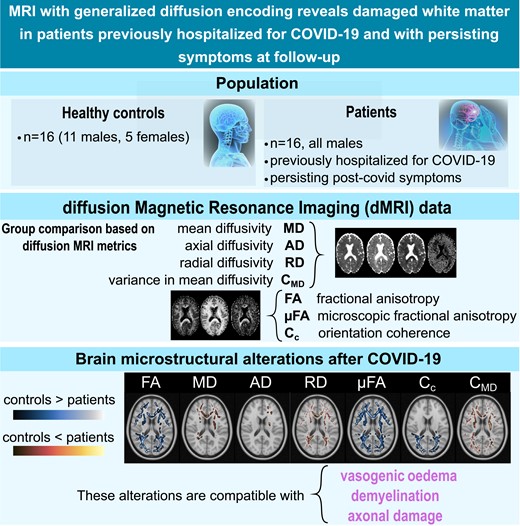2023-12-11 リンショーピング大学
◆リンシェーピング大学病院のイーダ・ブリースタッド博士と研究者チームは、新しいMRIイメージング技術である高度な拡散MRIを追加し、COVID-19後の持続的な症状を経験する患者の脳の白質構造を調査しました。COVID-19で入院した16人の男性と未入院でCOVID症状のない健康な対照グループを比較し、重症化したグループが異なる白質構造を示すことを発見しました。研究者たちはこれらの結果を慎重に解釈し、COVID-19の長期的な影響を理解するためにより高度なMRI技術が必要であると強調しています。
<関連情報>
- https://liu.se/en/news-item/changes-in-the-brain-after-covid-19-detected-using-advanced-mri-technology
- https://academic.oup.com/braincomms/article/5/6/fcad284/7326753
COVID-19で入院歴があり、追跡調査でも症状が持続している患者において、一般化拡散符号化法によるMRIで損傷した白質が発見される MRI with generalized diffusion encoding reveals damaged white matter in patients previously hospitalized for COVID-19 and with persisting symptoms at follow-up
Deneb Boito, Anders Eklund, Anders Tisell, Richard Levi, Evren Özarslan, Ida Blystad
Brain Communications Published:22 October 2023
DOI:https://doi.org/10.1093/braincomms/fcad284
Abstract
There is mounting evidence of the long-term effects of COVID-19 on the central nervous system, with patients experiencing diverse symptoms, often suggesting brain involvement. Conventional brain MRI of these patients shows unspecific patterns, with no clear connection of the symptomatology to brain tissue abnormalities, whereas diffusion tensor studies and volumetric analyses detect measurable changes in the brain after COVID-19. Diffusion MRI exploits the random motion of water molecules to achieve unique sensitivity to structures at the microscopic level, and new sequences employing generalized diffusion encoding provide structural information which are sensitive to intravoxel features. In this observational study, a total of 32 persons were investigated: 16 patients previously hospitalized for COVID-19 with persisting symptoms of post-COVID condition (mean age 60 years: range 41–79, all male) at 7-month follow-up and 16 matched controls, not previously hospitalized for COVID-19, with no post-COVID symptoms (mean age 58 years, range 46–69, 11 males). Standard MRI and generalized diffusion encoding MRI were employed to examine the brain white matter of the subjects. To detect possible group differences, several tissue microstructure descriptors obtainable with the employed diffusion sequence, the fractional anisotropy, mean diffusivity, axial diffusivity, radial diffusivity, microscopic anisotropy, orientational coherence (Cc) and variance in compartment’s size (CMD) were analysed using the tract-based spatial statistics framework. The tract-based spatial statistics analysis showed widespread statistically significant differences (P < 0.05, corrected for multiple comparisons using the familywise error rate) in all the considered metrics in the white matter of the patients compared to the controls. Fractional anisotropy, microscopic anisotropy and Cc were lower in the patient group, while axial diffusivity, radial diffusivity, mean diffusivity and CMD were higher. Significant changes in fractional anisotropy, microscopic anisotropy and CMD affected approximately half of the analysed white matter voxels located across all brain lobes, while changes in Cc were mainly found in the occipital parts of the brain. Given the predominant alteration in microscopic anisotropy compared to Cc, the observed changes in diffusion anisotropy are mostly due to loss of local anisotropy, possibly connected to axonal damage, rather than white matter fibre coherence disruption. The increase in radial diffusivity is indicative of demyelination, while the changes in mean diffusivity and CMD are compatible with vasogenic oedema. In summary, these widespread alterations of white matter microstructure are indicative of vasogenic oedema, demyelination and axonal damage. These changes might be a contributing factor to the diversity of central nervous system symptoms that many patients experience after COVID-19.
Graphical Abstract



